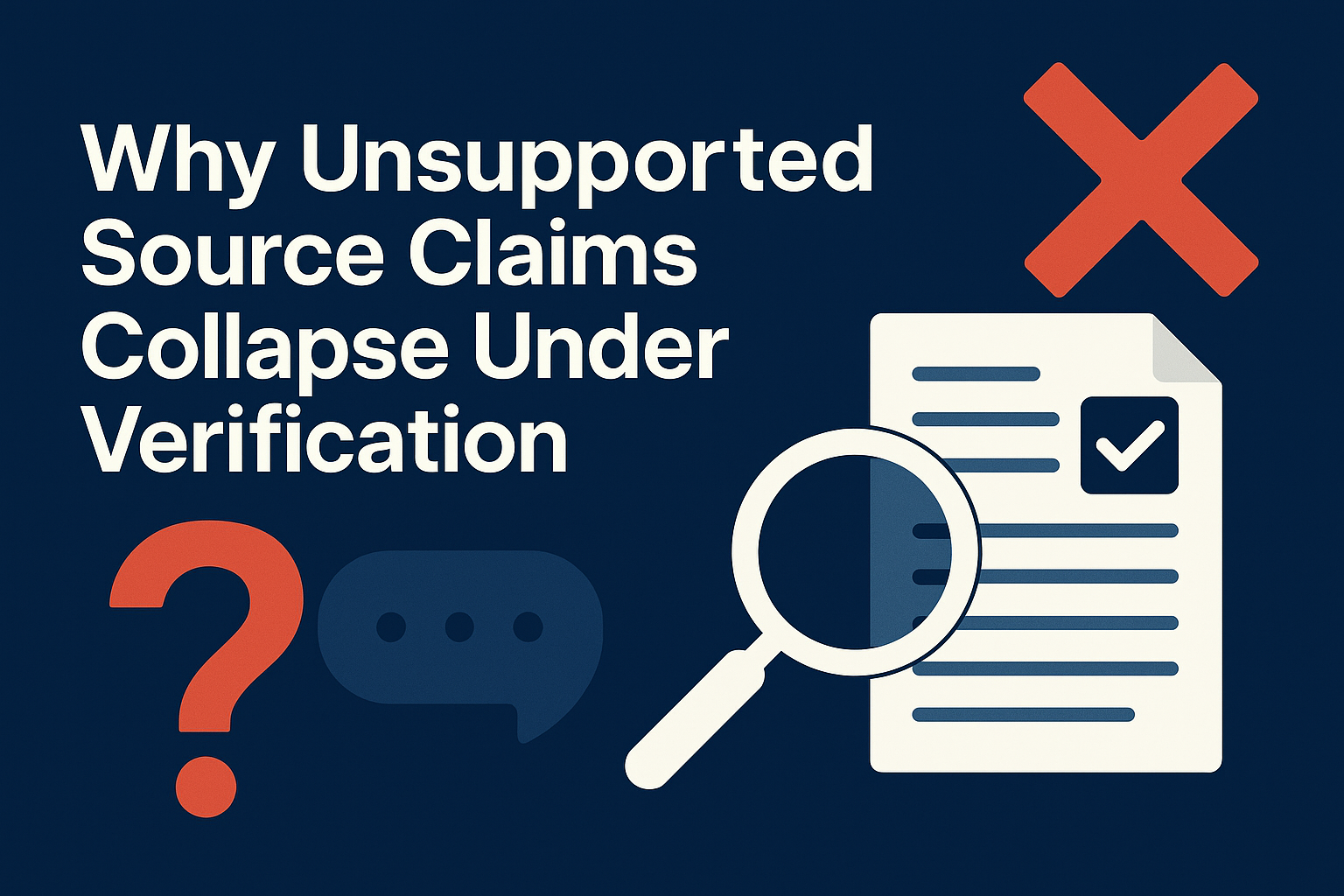Why Unsupported Source Claims Collapse Under Verification

This article follows up the Verification Protocol for Domain-Source Frequency Claims in AI Assistants by exposing the reasoning errors that make unverified domain influence claims unreliable in enterprise and audit contexts.
Abstract
The Verification Protocol for Domain-Source Frequency Claims in AI Assistants sets strict evidentiary standards for establishing which domains influence AI assistant outputs. This follow up explains why those standards are required.
Industry commentators often treat conversational surface patterns as indicators of authoritative source influence, yet these claims fail when tested under proper disclosure, classification, and replay conditions.
By tracing the reasoning errors behind such claims and examining a realistic case that collapses under verification, this article shows how the protocol protects enterprises from drawing false conclusions about source authority.
1. Why a Follow Up is Necessary
The protocol was created because many organisations began relying on unverified assumptions about where AI assistants draw their information from. These assumptions shaped visibility strategies, misinformation assessments, and content plans. They often appeared grounded in observation, but lacked reproducible evidence.
This follow up shows the specific reasoning failures that drove those claims and clarifies how the protocol corrects them.
2. The Central Misunderstanding
Observers frequently notice that assistant outputs contain conversational tone, anecdotal phrasing, or community style narratives. They then infer that those communities must be functioning as primary sources.
This is a category mistake.
Style reflects experiential signals.
Authority reflects factual grounding.
The protocol separates these by requiring explicit classification of source types and evidence of derivation. This follow up explains how often that separation is ignored.
3. Where Output Based Reasoning Fails
Unsupported claims tend to follow a recognisable pattern. These reasoning errors appear across dashboards, commentaries, and analyst reports.
3.1 Appearance treated as evidence
A mention or stylistic echo is mistaken for proof of source authority. Appearance alone says nothing about the underlying evidence chain.
3.2 Single observations treated as stable behaviour
Claims are often built on a handful of prompts without multi run or multi model replication. Without variance measurement, there is no basis for asserting domain influence.
3.3 Style mistaken for provenance
If an assistant uses phrasing that resembles community language, the community is interpreted as the origin. This conflates narrative tone with factual source.
The protocol prevents these errors by demanding full prompt disclosure, clear attribution rules, and reproducible replay. This article highlights the observed reasoning patterns that make these safeguards essential.
4. A Realistic Example of Collapse Under Verification
The following composite example is drawn from recurring industry patterns.
A dashboard provider publishes a report claiming:
“CommunityDomain is now the third most influential source for product research queries.”
The supporting evidence includes ten screenshots, a small table of mention counts, and a narrative suggesting that the assistant “speaks in the CommunityDomain style.” The claim appears persuasive at a glance.
When the protocol is applied, the claim fails on multiple fronts.
Prompt set not disclosed
The provider does not publish the complete prompt set, so independent evaluation is impossible. Under the protocol, this is non verifiable.
No differentiation between explicit and implicit references
Mentions, paraphrases, and stylistic cues are grouped as one category. This ignores the classification rules required to separate explicit citations from narrative influence.
No replayable evidence
Independent teams replicate prompts across multiple runs and models. CommunityDomain appears inconsistently and is often displaced by more authoritative domains. Variance is high. Under the protocol, this is non reproducible.
Narrative influence mistaken for authority
Where CommunityDomain appears, it contributes anecdotal context, not factual grounding. The dashboard has conflated experiential signals with source authority.
The claim collapses not because of minor errors, but because the underlying reasoning is unsound. The protocol makes this collapse visible.
5. What Controlled Testing Actually Shows
Once the protocol’s requirements are applied across assistants and prompt types, a consistent pattern emerges.
In experiential or anecdotal queries
Examples include “what is it like to” or “what do people usually recommend.” Here, community derived content often shapes tone or examples.
In factual, comparative, or compliance related queries
Examples include “who is the market leader,” “which option is best for enterprise use,” or “what are the regulatory requirements.” In these cases, assistants draw more heavily from authoritative sources such as documentation, structured data, and established professional reviews.
Across deeper conversational sequences
As a query evolves and the assistant is required to give specific, precise guidance, the influence of conversational patterns tends to diminish. Factual and structured signals become more prominent.
This pattern confirms that community content affects narrative surface but does not function as a primary authority layer.
6. Governance Impact for Enterprises
Unsupported claims about domain influence create three forms of governance risk.
- Visibility strategy built on weak assumptions
Enterprises may invest in channels that provide narrative texture rather than authoritative prominence. - Misinformation and trust assessments that fail under audit
If an organisation bases risk models on inferred authority that cannot be verified, it cannot defend those decisions when challenged. - Disclosure and reporting vulnerabilities
If claims about source influence inform official statements, they must withstand replay and independent verification. Unsupported claims do not.
The protocol exists to enforce evidentiary discipline. This article explains the behavioural patterns that make that discipline necessary.
7. Conclusion
The Verification Protocol for Domain-Source Frequency Claims in AI Assistants defines the evidentiary requirements for establishing domain influence. This follow up shows why those requirements are essential.
Unsupported claims fail because they rely on intuitive interpretations of tone, narrative style, or isolated outputs. Once subjected to full prompt disclosure, proper classification, and reproducible replay, such claims do not hold.
The protocol establishes the standard for evidence.
This article exposes the reasoning failures that the standard is designed to correct.

